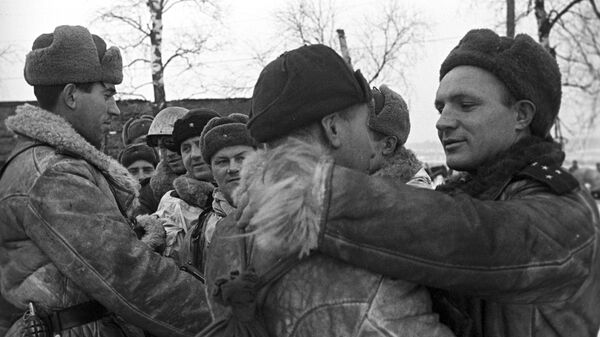https://sputniknews.com/20230118/spark-of-liberty-the-day-the-red-army-smashed-the-nazis-leningrad-blockade-1106436946.html
Spark of Liberty: The Day the Red Army Smashed the Nazi’s Leningrad Blockade
Spark of Liberty: The Day the Red Army Smashed the Nazi’s Leningrad Blockade
On January 18, 1943, Soviet forces scored an important victory against Nazi German forces besieging the ‘City of Lenin’, finally breaching the blockade which had lasted for over two years.
2023-01-18T07:00+0000
2023-01-18T07:00+0000
2023-01-18T07:00+0000
siege of leningrad
world war ii
anniversary
russia
/html/head/meta[@name=’og:title’]/@content
/html/head/meta[@name=’og:description’]/@content
https://cdnn1.img.sputniknews.com/img/07e7/01/11/1106436706_0:0:3120:1756_1920x0_80_0_0_c23c946c8e8bfb2103baddaac537d1b3.jpg
As German forces advanced all across the western Soviet Union during the initial stages of Hitler’s invasion in 1941, a sizeable force of Nazi troops moved to capture Leningrad, an important Soviet port and industrial city located on the Baltic coast.With the initial Nazi advance being repelled by the Soviet forces defending the city, German troops and their Finnish allies established a blockade around Leningrad, leaving the Soviet soldiers and civilians inside to starve.With the defenders’ supplies dwindling and only a narrow set of routes across the frozen Lake Ladoga available to bring food to the city, Leningrad refused to bow to the Nazi war machine, becoming an impregnable fortress that weathered the siege.People trapped inside the city by Nazi forces had to endure hellish conditions, with daily rations for civilians at one point being limited to only 125 grams of low-quality bread.Yet even as tens of thousands perished due to starvation, cold and constant bombardment by Nazi forces, others endured, stubbornly defending Leningrad.Meanwhile, the Soviet command worked tirelessly to relieve the city, launching several unsuccessful attempts to break the blockade, until one finally succeeded.Dubbed Operation Iskra (Spark), this undertaking involved the forces of the Red Army’s Volkhov and Leningrad fronts, as well as forces from the Soviet Baltic Fleet, smashing through the German forces maintaining the blockade on January 18, 1943.Even though the blockade was fully lifted only a year later in January 1944, the success of Operation Iskra marked the beginning of the end of the Nazi stranglehold on the city, allowing the Soviets to bring more supplies into Leningrad and drastically improve the lot of civilians and soldiers in the city.
Sputnik International
feedback@sputniknews.com
+74956456601
MIA „Rosiya Segodnya“
2023
News
en_EN
Sputnik International
feedback@sputniknews.com
+74956456601
MIA „Rosiya Segodnya“
Sputnik International
feedback@sputniknews.com
+74956456601
MIA „Rosiya Segodnya“
world war ii, siege of leningrad
world war ii, siege of leningrad
On January 18, 1943, Soviet forces scored an important victory against Nazi German forces besieging the ‘City of Lenin’, finally breaching the blockade which had lasted for over two years and threatened to starve the city residents.
As German forces advanced all across the western Soviet Union during the initial stages of Hitler’s invasion in 1941, a sizeable force of Nazi troops moved to capture Leningrad, an important Soviet port and industrial city located on the Baltic coast.
With the initial Nazi advance being repelled by the Soviet forces defending the city, German troops and their Finnish allies established a blockade around Leningrad, leaving the Soviet soldiers and civilians inside to starve.
With the defenders’ supplies dwindling and only a narrow set of routes across the frozen Lake Ladoga available to bring food to the city, Leningrad refused to bow to the Nazi war machine, becoming an impregnable fortress that weathered the siege.
People trapped inside the city by Nazi forces had to endure hellish conditions, with daily rations for civilians at one point being limited to only 125 grams of low-quality bread.
Yet even as tens of thousands perished due to starvation, cold and constant bombardment by Nazi forces, others endured, stubbornly defending Leningrad.
Meanwhile, the Soviet command worked tirelessly to relieve the city, launching several unsuccessful attempts to break the blockade, until one finally succeeded.
Dubbed Operation Iskra (Spark), this undertaking involved the forces of the Red Army’s Volkhov and Leningrad fronts, as well as forces from the Soviet Baltic Fleet, smashing through the German forces maintaining the blockade on January 18, 1943.
Even though the blockade was fully lifted only a year later in January 1944, the success of Operation Iskra marked the beginning of the end of the Nazi stranglehold on the city, allowing the Soviets to bring more supplies into Leningrad and drastically improve the lot of civilians and soldiers in the city.

